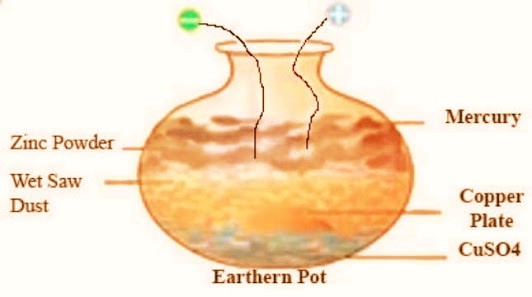Rishi Agastya
In ancient India, there were numerous gadgets for example high flying balloons, parachutes, electricity, and batteries. The sages of India created science alongside religion. Around then there were airplanes, electricity, there were additionally space ships to go into space. Today, people may not believe it, but explorers have gradually started to acknowledge it. We all have been learned that foreign scientists such as Newton, Einstein, and Benjamin Franklin had invented Power, bulbs, and batteries. However, what has not been taught to us is that the electricity was being utilized in India thousands of years before that. Many of us do not realize that Agastya Rishi was the father of the electricity and electric battery.
Introduction of Agastya Rishi-
Maharishi Agastya was one of the Saptrishi and he was the elder brother of Sage Vashistha who was KulGuru of King Dasharath. Agastya Rishi lived in Northern India however on the request of the Gods, he left Kashi and moved to the south and later settled there.
Agastya Rishi is one of the incredible sages. The basic formula for creating electricity is based on the ancient principles of Rishi Agastya. The code composed by him covered the tremendous knowledge of subjects including a formula for making a battery. In the code, Agastya has mentioned several theories to create clean energy thereby providing electricity with natural resources. Furthermore, similar theories are even followed by the advanced batteries we use today.
Vedic-electrical-cell
Agastya Samhita written around by sage Agatsya, describes method to make dry electric cell with 1.138 volts and 23 mA and electroplating process, hydrogen balloons.
Agastya Samhita-
Sage Agastya composed a book called ‘Agastya Samhita’. There is a lot of discussion about this book. Surprisingly, the sources related to power generation are found in this book.
Bulb inventor Thomas Edison writes in one of his books that — “one night I slept while reading a Sanskrit sentence. That night I realized in my dream the meaning and mystery of that Sanskrit word that helped me make bulbs”.
The ancient text of Agastya Samhita describes the method of making electric battery, and that water can be split into oxygen and hydrogen. Modern battery cell resembles Agastya’s method of generating electricity. For generating electricity, Sage Agastya had used the following material:
1. One earthen pot
2.Copper plate
3.Copper sulphate
4.Wet saw dust
5.Zinc amalgam
Agastya Samhita portrays the formula of making an Electric battery, and that water can be divided into oxygen and hydrogen. one of the texts of Agastya Samhita says-
संस्थाप्य मृण्मये पात्रे ताम्रपत्रं सुसंस्कृतम्।
छादयेच्छिखिग्रीवेन चार्दाभि: काष्ठापांसुभि:॥
दस्तालोष्टो निधात्वय: पारदाच्छादितस्तत:।
संयोगाज्जायते तेजो मित्रावरुणसंज्ञितम्॥
“Sansthapya Mrinmaya Patre Tamrapatram Susanskritam Chhadyechhikhigriven Chardrarbhih Kashthpamsubhih. Dastaloshto Nidhatavyah Pardachhaditastah Sanyogajjayte Tejo Mitravarunsangyitam”
Which means, “Place a well-cleaned copper plate in an earthenware vessel. Cover it first by copper sulfate and then by moist sawdust. After that, put a mercury-amalgamated zinc sheet on top of the sawdust to avoid polarization. The contact will produce an energy known by the twin name of Mitra-Varuna. Water will be split by this current into Pranavayu and Udanavayu. A chain of one hundred jars is said to give a very effective force. (p. 422)”
When a cell was prepared according to Agastya Samhita and measured, it gives open circuit voltage as 1.138 volts, and short circuit current as 23 mA.
In the above verse-
ताम्रपत्रं means(Copper Sheet)
Mitra is Cathode
Varuna is the Anode
शिखिग्रीवा means Copper sulfate
दस्तलोष्ट means(Zinc)
मित्रावरुणशक्ति (Electricity).
Agastya Samhita also gives details of using electricity for Electroplating. He figured out the method of polishing copper or gold or silver by the battery, Due to such brilliant invention, Rishi Agastya is also called Kumbodbhav (Battery Born).
अनने जलभंगोस्ति प्राणोदानेषु वायुषु। एवं शतानां कुंभानांसंयोगकार्यकृत्स्मृत:॥ -अगस्त्य संहिता
Anen Jalbhangosti Prano Daneshu Vayushu Evam Shatanam Kumbhanamsanyogkaryakritsmritah.
Maharishi Agastya says- if we use the power of 100 earthen pots (hundred cells made in the above manner and added in series) on water, then water will change its form into life-giving oxygen and floating hydrogen.
Here प्राणवायु means Oxygen,उदान वायु means Hydrogen.
वायुबन्धकवस्त्रेण निबद्धो
यानमस्तके
उदनः स्वलघुत्वे
बिभर्त्याकाशयानकम्.
Vayubandhakvastren Nibaddho Yanmastake Udanah Swalaghutve Bibhartyakashayanakam.
If hydrogen is contained in an air tight cloth, it can be used in aerodynamics, i.e. it will fly in air. (Today’s Hydrogen Balloon)
xcerpt from “Technology of the Gods: The Incredible Sciences of the Ancients” – By David Hatcher Childress In the temple of Trivandrum, Travancore, the Reverned S. Mateer of the London Protestant Mission saw ‘a great lamp which was lit over one hundred and twenty years ago’, in a deep well in side the temple. …….
On the background of the Agastya Samhita text’s giving precise directions for constructing electrical batteries, this speculation is not extravagant.”
Sage Agastya’s accomplishment as one of India’s oldest and wisest Rishis is surprising that shows the prosperous history and culture of India. We are unaware of the information provided in our Puranas, while the Western countries have followed our Puranas for carrying out all major inventions. We should read our Vedas and know how the Indian Rishi’s were having a treasure of knowledge and had done inventions much before any other country.
Reference : https://t.co/tFV2uibbGj



No comments:
Post a Comment